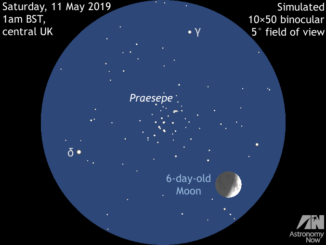
Messier 44


Seek out 1998 OR2, the brightest predicted near-Earth asteroid encounter of 2020
A near-Earth object (NEO) and potentially hazardous asteroid (PHA) with the catchy official name of 52768 (1998 OR2) passes just 16.4 lunar distances (6.3 million kilometres) from Earth at 09:56 UT on Wednesday, 29 April 2020. Here’s our guide to locating this fascinating asteroid in 15-cm (6-inch) aperture telescopes and smaller from the UK this month.


See the Moon buzz the Beehive Cluster on 10-11 May
UK skywatchers with a view low to the west between midnight and moonset on Saturday, 11 May 2019 can see the 6-day-old waxing crescent Moon close to Messier 44, otherwise known as Praesepe, or the Beehive Cluster. Later, observers on North America’s Eastern Seaboard can see the Moon pass in front of this glorious open cluster just before local midnight on 10 May.

Pirouetting Pleiads provide clues to stellar structure and evolution
Like cosmic ballet dancers, the stars of the Pleiades cluster are spinning, but all at different speeds. By watching these stellar dancers, NASA’s Kepler space telescope has helped amass the most complete catalogue of rotation periods for stars in a cluster. This information can provide insight into where and how planets form around these stars, and how such stars evolve.
